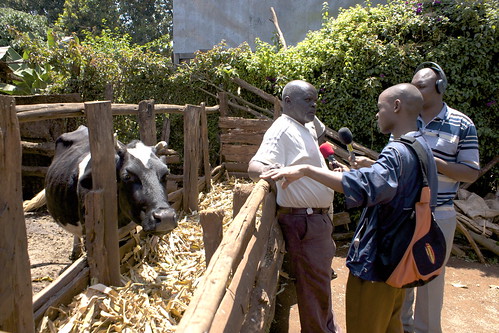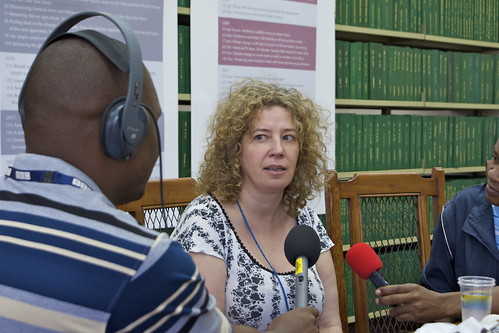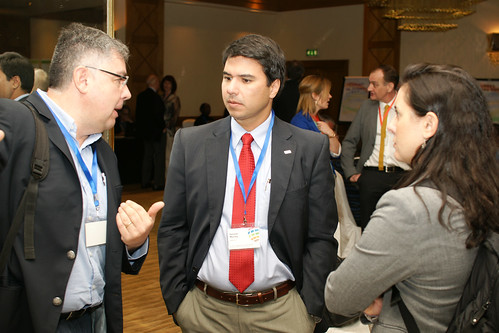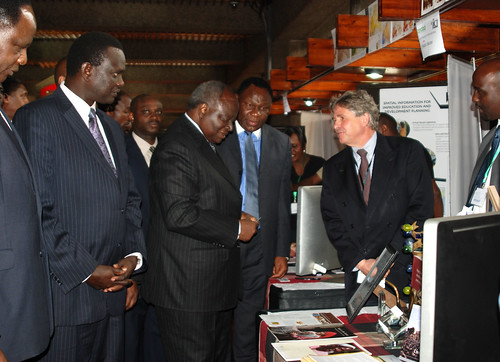
Leonard Gitau, a small-scale livestock farmer in Dagoretti, Nairobi, speaks to journalists during a media tour by ILRI of urban farmers in Nairobi on 21 Sep 2012 (photo credit: ILRI/Paul Karaimu).
For the first time in history, more people are living in cities than rural areas. Many of them still keep livestock. At least 800 million people in cities in developing countries practice urban agriculture, from growing vegetables to keeping camels—often in close confinement in densely populated areas.
The benefits of urban livestock keeping are many: from improved food security, nutrition and health from livestock products, creation of jobs and protection from food price volatility. But the risks in urban livestock are also large: unsanitary conditions and weak infrastructure mean that livestock can be a source of pollution and disease.
‘Zoonoses’, diseases transmitted between animals and people, are a global health problem that particularly affects the poor in developing countries. A new study by the International Livestock Research Institute (ILRI) and partners finds that zoonoses and diseases recently emerged from animals make up 26% of the infectious disease burden in low-income countries, but just 0.7% of the infectious disease burden in high-income countries.
The study, published in the journal Tropical Animal Health and Production, which was led by University of Nairobi and ILRI, is part of a series of papers that examine the facts and fiction of urban livestock keeping. The researchers note the need for evidence in the planning and practice of urban food systems and the danger of relying on perceptions or models taken from different contexts.
Here are some of the results of the study.
LOTS OF URBAN LIVESTOCK
Much more livestock is being raised in the urban areas of developing countries than most people (and policymakers) think.
THE DISEASE RISK
Domestic as well as wild animals can spread many, and some very serious, diseases to people and it is a reasonable assumption that as the population of urban areas of these and other developing countries continues to increase, the risk of zoonoses also increases.
THE GOOD NEWS
This recent in-depth study of urban zoonoses in urban environments in Nigeria and Kenya suggests that the human disease risk posed by raising, processing, marketing and/or consuming livestock in cities, city suburbs and big towns in developing countries is less than we might think.
SUPPORT INFORMAL MARKETS
Rather than bar poor people from livestock enterprises in urban areas in an attempt to protect public health, which could do the poor more harm than good, this study suggests that a more practical and equitable course is to work to enhance practices in small-scale urban livestock raising and informal livestock marketing by encouraging poor livestock producers, processors and sellers to upgrade some of their practices.
PROVIDE INCENTIVES FOR GOOD BEHAVIOUR
This study included participatory work with the local communities, and an important outcome has been the success achieved by creating incentives for the poor to improve their livestock practices rather than trying to strictly regulate these informal livestock markets, or harass the people involved, or bar them from operating altogether.
DISEASE RISKS ARE NOT WHAT WE THINK
Another important finding is that people are not the good judges of risks that they think they are; most people, including food safety officials, think that livestock foods, being so perishable, carry the greatest risk of disease in informal urban markets, but studies have shown that, for example, city vegetables are often a greater cause of disease concern than milk and meat.
TRACKING PATHOGENS AND RELATED ILRI RESEARCH
This research project was conducted jointly with the University of Nairobi, whose Professor Erastus Kang’ethe led the data collection and participatory work within Kenya, with the support of the Kenyan government and health officials. This project also expands ILRI’s long-standing research on informal dairy markets in East Africa and South Asia, led by ILRI scientist Amos Omore and others, which helped to refine dairy policies to support rather than harass sellers of ‘raw’ (unpasteurized) milk. And a new ILRI research project led by ILRI scientist Eric Fevre will investigate zoonoses further by tracking disease pathogens as they move among farms, processors and markets in Nairobi.

ILRI scientist Delia Grace is interviewed by BBC and AllAfrica.com before the start of a journalist tour of urban livestock farmers in Nairobi that ILRI organized on 21 Sep 2012 (photo credit: ILRI/Paul Karaimu).
Delia Grace, an ILRI veterinary epidemiologist and leader of a component of the CGIAR Research Program on Agriculture for Nutrition and Health, was the principal investigator in the Ibadan-Nairobi zoonoses study and editor of this special edition of Tropical Animal Health and Production. Grace says that regulations that work for rich countries do not always work for poor countries, and that policies should follow a risk-based approach where decision-makers’ focus is not the bugs present in food but the likely effects on human health. ‘The risks of food-borne diseases’, she says, ‘need also be weighed against the economic benefits and nutrition abundantly supplied by animal products.’
In the absence of evidence, policies are based on the prejudice that urban livestock keeping is unsafe and unmodern, and it is often banned outright. Of course it continues behind hedges and in back alleys, but the imposed illegality drives a rush to the bottom in hygienic practices and investments. When farmers are harassed by authorities and operate in a legal grey area, they have little access to the support they need and little incentive to invest in business improvements.
Thanks in part to previous research on the benefits of urban agriculture, the Government of Kenya has been proactive in posting veterinary, animal production, and crop personnel in major urban centers to lead from the front in championing the development of urban agriculture. The government has also led in the development of the urban agriculture and livestock policy. Involving these civil servants has been key in enabling our research in urban agriculture. This is a good example of government changing its policy to better meet the needs of citizens.
Rapid urbanization, and along with it the urbanization of poverty and food insecurity, raises urgent challenges for the global research and development community. Among them is the need to manage the growing risks of zoonosis associated with urban farming and to improve food safety for the one billion of the world’s poor living in cities, most of whom depend on informal markets instead of more formal government-organized markets or grocery stores.
Informal, or wet markets, exist in many different forms across Africa and Asia but have common characteristics: food escapes effective health and safety regulation; many retailers do not pay tax and some are not licensed; traditional processing, products and retail practices predominate; infrastructure such as water, electricity, sanitation, and refrigeration is lacking; and little support is provided from the public or non-governmental sector. Unsurprisingly, women and the poor are involved most in informal markets.
Applying an innovative research approach known as ‘ecohealth’, the findings of this research contradict some basic assumptions about zoonoses and urban farming and show how livestock keepers in one of Africa’s biggest cities, Nairobi, Kenya, are transforming their livestock and public health practices to combat disease and help feed a city where 60% of the population lives in slums.
But what does it mean in practice? A special edition of 11 papers sets out how ecohealth approaches can make a difference to city health. The researchers base their findings from two case studies. One is in Dagoretti, a Nairobi district of some 240,000 residents, and analyzes the emerging zoonoses cryptosporidiosis, a diarrhoeal disease that is passed from cattle to humans.
For further information
See a Factsheet on Urban Agriculture and Zoonoses in Nairobi, which provides key facts about urbanization, urban livestock keeping and the study in Dagoretti, where most residents are poor and many raise livestock inside city limits.
Read the special supplement of the August 2012 issue of the journal Tropical Animal Health and Production on assessing and managing urban zoonoses and food-borne disease in Nairobi and Ibadan.
Featured in the special supplement are the following 10 research articles by scientists from the International Livestock Research Institute (ILRI) and partners from the Kenya Agricultural Research Institute (KARI), the Kenya Ministry of Agriculture, the Federal University of Agriculture, Abeokuta, the University of Ibadan and the University of Nairobi.
Click on the links below to read the abstracts of the articles (ILRI authors in burgundy; journal subscription required for access to full text).
-
Evaluating a group-based intervention to improve the safety of meat in Bodija Market, Ibadan, Nigeria, by Delia Grace, Morenike Dipeolu, Janice Olawoye, Ernest Ojo, Stella Odebode, Michael Agbaje, Gabriel Akindana, Thomas Randolph.
-
Social and gender determinants of risk of cryptosporidiosis, an emerging zoonosis, in Dagoretti, Nairobi, Kenya, by Violet N. Kimani, Grace Mitoko, Brigid McDermott, Delia Grace, Julie Ambia, Monica W. Kiragu, Alice N. Njehu, Judith Sinja, Joseph G. Monda, Erastus K. Kang’ethe.
-
Development and delivery of evidence-based messages to reduce the risk of zoonoses in Nairobi, Kenya, by Erastus Kang’ethe, Violet Kimani, Delia Grace, Grace Mitoko, Brigid McDermott, Julie Ambia, Concepta Nyongesa, Gabriel Mbugua, William Ogara, Peninnah Obutu.
-
A trans-disciplinary study on the health risks of cryptosporidiosis from dairy systems in Dagoretti, Nairobi, Kenya: Study background and farming system characteristics, by Erastus K. Kang’ethe, Violet N. Kimani, Brigid McDermott, Delia Grace, Alfred K. Lang’at, Monica W. Kiragu, Nancy Karanja, Alice N. Njehu, Thomas Randolph, Gabriel Mbugua, Tabitha W. Irungu, Peninnah Ombutu.
-
Prevalence of cryptosporidiosis in dairy cattle, cattle-keeping families, their non-cattle keeping neighbours and HIV-positive individuals in Dagoretti Division, Nairobi, Kenya, by Erastus Kange’the, Brigid McDermott, Delia Grace, Cecilia Mbae, Erastus Mulinge, Joseph Monda, Concepta Nyongesa, Julie Ambia, Alice Njehu.




